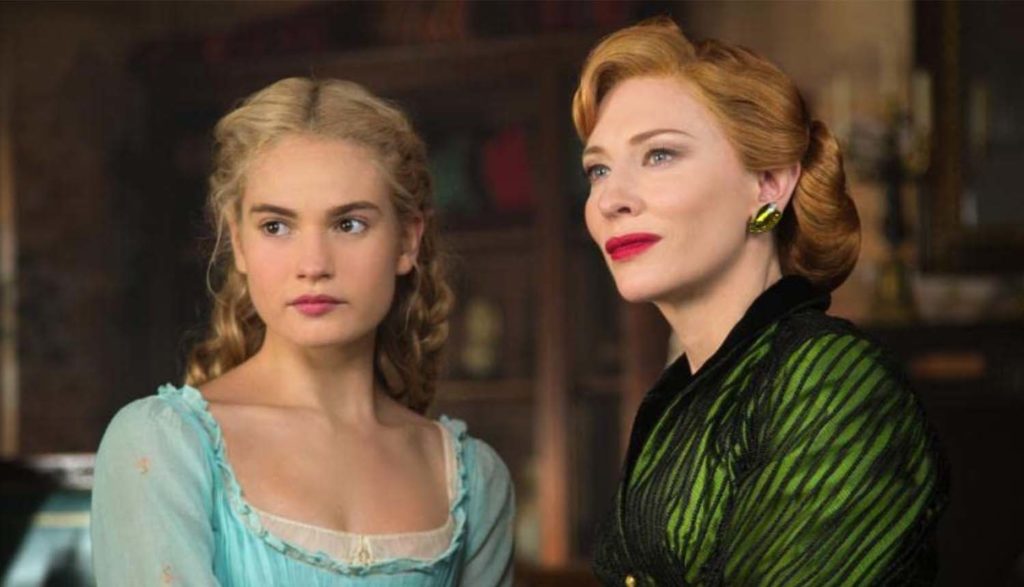
Many a fairy tale concludes with, “And they lived happily ever after.” Fewer begin from such a place. But for Ella, life was indeed a fairy tale.
You see, Ella could hardly have had a more idyllic existence. Growing up in a ramshackle country mansion, her days consist of “talking” to her animal friends (especially four mice who live in the house) and basking in the delight of her doting parents.
Until, that is, Ella’s mother takes mortally ill. On her death bed, mother beckons Ella close to tell her “a great secret that will see you through all the trials life has to offer: have courage and be kind.”
Ella could hardly know how crucial that secret will become.
As the years roll by, Ella and her father, a merchant, enjoy life as much as they can. But melancholy fills her father’s heart, a longing for companionship. And so, when he meets a beautiful widower with two daughters about Ella’s age, it seems a perfect opportunity for a second chapter of familial bliss.
Except that it isn’t.
Lady Tremaine is as cruel as her daughters are vain. And when Ella’s father dies on a journey, she’s forced to cling ever-more-tightly to her mother’s counsel. “Have courage and be kind.”
As Ella’s status slips from stepsister to servant to slave, she does her best to heed her mother’s advice. Lady Tremaine soon banishes her to the attic, a dank and dusty cell where Ella’s only solace is her journal, her mice friends and her memories of a better life.
And then one fateful day, she encounters a dashing young man named Kit who’s hunting a massive stag. Ella—who’s been “talking” to said stag—convinces the handsome hunter that the glorious beast has more living to do. And her persuasive passion accomplishes more than that, enchanting the heart of a noble young man she has no idea is the kingdom’s crown prince.
Prince Kit—whom his aging father, the King, wants to see married off—is smitten. So when the time arrives for a ball from which the prince is instructed to pick his bride, he argues ardently that maidens from across the kingdom should be invited.
There’s only one he’s interested in, of course.
Ella—who’s taken to sleeping next to the house’s hearth to keep warm, a sooty bed that’s prompted her sisters Anastasia and Drizella to rename her Cinderella—longs to attend. But her hope is ripped apart when her wicked stepmother shreds Ella’s dress, a beloved heirloom from her mother, and commands her to stay at home while Lady Tremaine and her narcissistic, scheming daughters attend.
All hope seems lost.
Until Ella’s fairy godmother appears, that is. A fairy godmother whose magical plan to get Ella to the ball—complete with an extreme wardrobe makeover and dazzling glass slippers—is something that no one, not Ella, not her stepmother and not the crown prince pining of his mysterious country girl, ever saw coming.
Ella’s girlhood home is as happy as it could possibly be. She enjoys the love of two parents who cherish her completely, encouraging their daughter’s tenderhearted, pseudo-magical communion with animals around their farm-like estate. It’s a beautiful picture of familial affirmation and affection, and it’s an environment in which Ella’s soul flourishes.
After Ella’s father meets Lady Tremaine and suggests to his daughter that he’s considering marrying her, he asks his now young adult daughter, “Do you think I might be allowed a second chance at happiness?” Ella bravely encourages her father to pursue that chance, not knowing, of course, that her father has been deceived by the manipulative, desperate and conniving Lady Tremaine.
Before he dies, Ella’s father speaks of the importance of the home where they live. He says of this deceased wife, “She’s the heart of this place. We must cherish this house.” After his death, Ella remains in the home despite Lady Tremaine’s borderline torturous treatment of her chiefly because of her allegiance to the house as an important part of her family’s legacy.
A servant delivers Ella’s father’s last tender message to his daughter, saying, “To the end, he spoke only of you, miss. And your mother.” Lady Tremaine overhears that, and it only fuels her contempt.
When Ella meets Kit in the forest (she’s horseback riding), she tries to persuade him to cease his hunt of a great stag she’s just seen and been communing with. “We must simply have courage and be kind, mustn’t we?” she says. The prince is as yet unmoved, saying that hunting animals is just the kind of thing that he does. “Just because it’s done doesn’t mean it should be done,” Ella responds, logic that the prince later uses to convince his father that he should be free to marry the woman of his choosing instead of a rich and powerful princess, as his father initially want him to do. His noble character is further underscored by his unshakeable willingness to marry Ella, a commoner with no dowry or royal influence to offer him. (For their part, the king and his son have a strong, loving relationship, too, one that improves as the movie goes on.)
In one exchange with Lady Tremaine, Ella asks her, “Why are you so cruel? I tried so hard to be kind to you.” Lady Tremaine says simply, “Why? Because you are young and innocent and good. And I—” she stops short, clearly implying that she’s none of those things. Eventually, Ella ends up with her prince of course. And she graciously tells Lady Tremaine, “I forgive you.”
Ella’s mother tells her that fairy godmothers look after humans in the same way that Ella looks after her animals. When Ella asks if she really believes that, her mother says, “I believe in everything.” Ella responds, “Then I believe in everything, too.”
At a crucial moment after long enduring her stepmother’s vicious treatment, Ella begins crying and apologizes to her deceased mother, saying, “I’m sorry mother. I’m sorry. I said I’d have courage. But I don’t. I don’t believe anymore.” At that point, her Fairy Godmother appears. At first she’s in the form of a haggard beggar. But she transforms herself magically into a more beautiful form. She then transforms a pumpkin into a carriage, and magically metamorphoses Ella’s animal friends too. The four mice become its horses. Two lizards become the carriage’s footmen, and a goose becomes its driver. The Fairy Godmother warns Ella that everything will return to its mundane form at the end of the last echo of the last bell chime at midnight.
The Fairy Godmother transforms Ella’s dress and shoes, too. The dazzling, magical glass slippers she wears, we learn, will only fit her feet.
Lady Tremaine’s mean cat is name Lucifer. When the stepmother tries to deny the king’s men access to Ella, one asks her, “Are you an empress … or a diety?”
Women (including Cinderella) wear low-cut, cleavage-revealing dresses throughout. Anastasia and Drizella are shown in under-gown garments. Cinderella and the Prince share a kiss; her parents kiss once, too.
When the Fairy Godmother transforms the pumpkin, it’s in a relatively small glass greenhouse that is smashingly destroyed in the process.
Ella’s parents both succumb to illness. We see her mother quite ill before she dies but only hear of her father’s death from a messenger. Near Ella’s mother’s death, the older woman says, “I must go very soon, my love. Please forgive me.” Likewise, Prince Kit’s father, the king, is terminally ill too.
Some slapstick pratfalls involve Ella’s stepsisters. One of them threatens to scratch the other’s eyes out. Ella’s flight from the ball involves mildly perilous pursuit by the king’s men.
Three characters die, one of which passes away quietly in his bed.
Singular exclamations of “oh gosh,” “oh my goodness” and “bloomin'” (a euphemism for the British profanity “bloody”). A woman says of the arrival of the king’s men, “Oh lords.” Lady Tremaine tells her daughters to “shut up” at least three times. She calls Ella a “vulgar young hussy,” a “wench” and a “wretch.”
Lady Tremaine is shown knocking back a drink in one scene.
Lady Tremaine hosts a raucous party in Ella’s home shortly after marrying her father that involves guests gambling. A woman’s smelly feet cause the king’s men to faint while trying to put the slipper on her foot.
Lady Tremaine and her daughters treat Ella dreadfully from start to finish, taking joy in ordering her around, making her do every household task and generally treating her as a despised menial servant. Lady Tremaine labels her own daughters as “stupid.”
I think Walt Disney, were he still around, would be proud of what the caretakers of his fabled legacy have done with the 2015 version of Cinderella. It’s largely true to the original story. And where it deviates and expands upon it, it does so in ways that add nuance and depth that arguably weren’t quite as present in Disney’s 1950 animated version.
The film’s repeated emphases on kindness and courage, which culminate in Ella graciously forgiving her wicked stepmother in the end, frankly give this version of a story that’s been around for several centuries an unexpectedly virtuous resonance. Certainly Downton Abbey star Lily James is a vision of radiant beauty. But her outward beauty is poignantly augmented by her inner beauty, namely her steadfast determination to stay true to her mother’s ideals of kindness and courage, which she manages to do despite the horrible verbal and emotional abuse heaped about her by her stepmother and stepsisters. The result is a thoroughly delightful reboot of a story we all know so well.
The film is, as you’d hope, almost completely devoid of content concerns that would spoil it for young viewers. The main issue parents might want to consider, especially when it comes to younger, impressionable would-be “princesses,” is the depiction of virtually every female character in low-cut dresses and cinched up in painful corsets. It’s par for the course for period pieces like these, of course, so much so that we might not even give it a second thought.
Still, with so many studies indicating that we take our body image cues from popular media, there may be messages unintentionally being sent here that parents of young girls would do well to work through together.
Apart from that concern, the 2015 version of Cinderella offers proof that the folks at Disney can—when they choose to—deliver the “happily ever after” goods without pandering unnecessarily to 21st-century sensibilities in disappointing ways.


After serving as an associate editor at NavPress’ Discipleship Journal and consulting editor for Current Thoughts and Trends, Adam now oversees the editing and publishing of Plugged In’s reviews as the site’s director. He and his wife, Jennifer, have three children. In their free time, the Holzes enjoy playing games, a variety of musical instruments, swimming and … watching movies.
Our weekly newsletter will keep you in the loop on the biggest things happening in entertainment and technology. Sign up today, and we’ll send you a chapter from the new Plugged In book, Becoming a Screen-Savvy Family, that focuses on how to implement a “screentime reset” in your family!